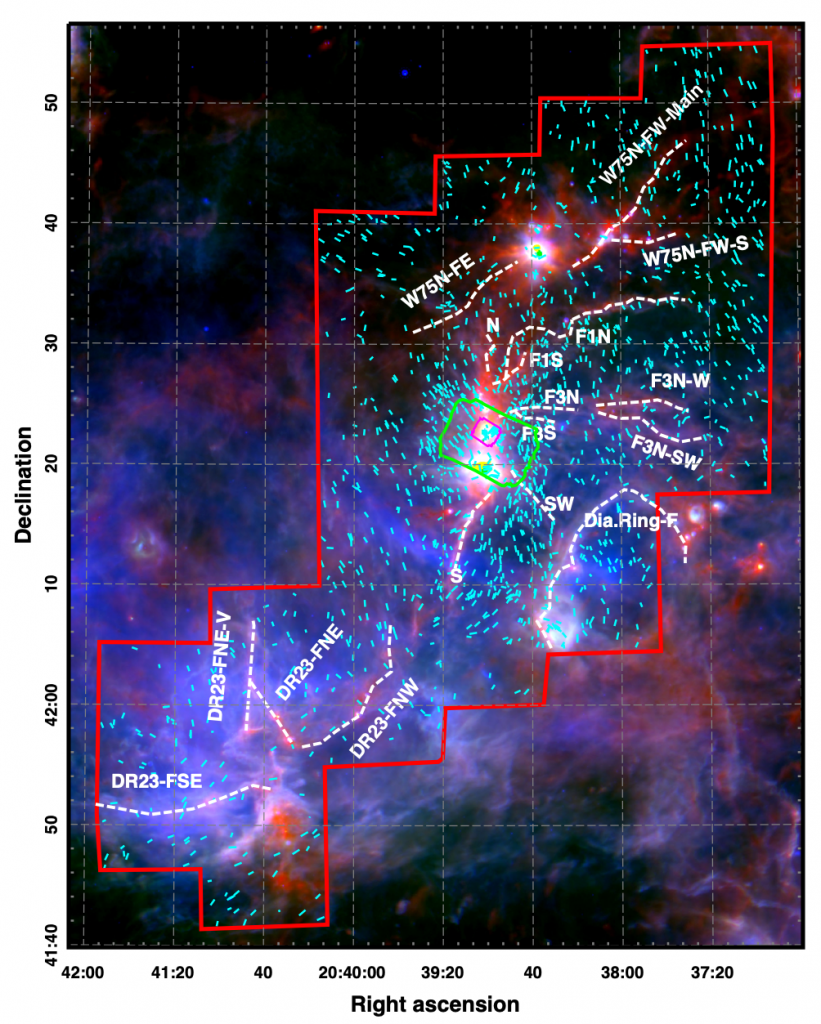by Anashe Bandari
Hidden behind a dark band of dust known as the Great Rift, the Cygnus-X star formation region is more than a bit of a mystery. Astronomers haven’t quite figured out what the molecular clouds in Cygnus-X are doing, and why, but observations from the Stratospheric Observatory for Infrared Astronomy (SOFIA) may help.
These mysteries relate to the fact that Cygnus-X is a difficult region to study. Two of its clouds – DR21 and W75N – clearly have separate gas velocities, but which cloud is in front of the other, and whether or not the two clouds are colliding, are open questions. Dan Clemens, an astronomer at Boston University, is the principal investigator on a project using SOFIA to examine Cygnus-X and the effects of magnetic fields on its clouds and cloud filaments. Details of these studies were presented at the June 2022 meeting of the American Astronomical Society.

“You can think of it as a pasta bowl with all these threads going in,” said Clemens. “Which pasta is in front of which pasta? Are there separate piles of pasta, or are they interacting piles of pasta that cause stars to form?”
On top of this, the presence of magnetic fields adds further complexity. What these magnetic fields are doing – whether they are passive participants in the clouds’ dynamics or helping to direct mass flows – is a question the SOFIA data may help answer by looking at small-scale filaments within the clouds.
Using SOFIA’s High-resolution Airborne Wideband Camera Plus (HAWC+), Clemens and his team zoomed in on Cygnus-X to look at the polarizations of the filaments at far-infrared wavelengths. These polarizations indicate the directions of the small-scale magnetic fields in the region, which the researchers use to determine the role the fields are playing.
“We want to ascertain the nature of the magnetic fields along these filaments, where they begin, and where they end,” Clemens said. “This will help test our best star formation models and notions.”
Most modern theories of star formation hint that magnetic fields may be channeling gas flows within molecular clouds toward a central hub, where massive star formation occurs. The SOFIA observations will reveal the magnetic fields in filaments within the clouds, helping to verify the idea that fine, weak magnetic fields can control how stars form.
According to the team’s analysis, there appear to be four distinct layers of gas and dust between us and the northern region of Cygnus-X. Whether or not these layers are interacting will affect their understanding of SOFIA’s magnetic field data. As such, Clemens and his collaborators will need to determine which cloud is in front of the other, and if they are going to collide, before the SOFIA data – and supporting wider-field, ground-based, near-infrared data – describing the magnetic fields can be effectively interpreted.
SOFIA is a joint project of NASA and the German Space Agency at DLR. DLR provides the telescope, scheduled aircraft maintenance, and other support for the mission. NASA’s Ames Research Center in California’s Silicon Valley manages the SOFIA program, science, and mission operations in cooperation with the Universities Space Research Association, headquartered in Columbia, Maryland, and the German SOFIA Institute at the University of Stuttgart. The aircraft is maintained and operated by NASA’s Armstrong Flight Research Center Building 703, in Palmdale, California. SOFIA achieved full operational capability in 2014, and the mission will conclude no later than Sept. 30, 2022. SOFIA will continue its regular operations until then, including science flights and a deployment to New Zealand this summer.
